
Thai Trade Ceramics
Since the Tang period, China was the main supplier of ceramics through the maritime trade route which spanned East/Southeas Asia and the West reaching as far as East Africa. However, during the Ming Hongwu period, the imperial court imposed a close door policy and banned private foreign trade. Foreign trade was permitted only through the tributary system. This resulted in a shortage of ceramics supply in the overseas market. However, this situation was temporary. In fact, it opened up a window of opportunity for Vietnam and Thailand to further develop their ceramics industry. During the duration of 15th century, they became the major ceramics suppliers to the Southeast Asia market. Vietnamese and Thai iron-painted wares were popular during the first half of the 15th century. However by in the second half of 15th century Thai celadon and Vietnamese blue and white wares were the main products demanded by the Southeast Asia consumers.
This chronology of the types of Southeast Asian ceramics that were produced in the 15th century only became clearer in recent years. Dr Roxanna M Brown is the foremost expert in the study of Southeast Asian ceramics and its role in the maritime trade of the 15th Century. In the last 20 years, a number of shipwrecks with Southeast Asian ceramics were discovered in the sea floor of Southeast Asia. The late Dr. Brown studied the finds from the wrecks and gathered sufficient information to develop her doctorate thesis on the chronology of Thai ceramics. The Chinese ceramics which a firmer dating is available is crucial to date ceramics in the cargo. This short article on Thai Trade Ceramics draws on her research which is available in the recently published book "The Ming Gap and Shipwreck Ceramics in Southeast Asia - Towards a Chronology of Thai Trade ware". It is indeed a worthy tribute to her contribution to the study of Thai ceramics.
Ceramics from production centre in Si Satchanalai and Sukhothai (the two most important cities of the Sukhothai kingdom) manufactured the bulk of the Thai trade ceramics of the 15th century. Over 50 kilns were found north of the city wall of old Sukhothai town. Si Satchanalai has the largest number of kilns located in 3 areas along the Yom river. The first cluster of about 20 kiln is at the village of Pa Yang, less than 1 km north of the old city wall of Si Satchanalai. About 1.5 km north, there is a cluster of 6 kilns which appears to also specialise in the manufacture of figurines termed Tukatha (dolls) in Thai. Ban Ko Noi situated about 5 km north of the city wall, has the largest cluster of kilns with more than 300 discovered so far. The trade ceramics in those areas are similar and commonly called Sawankhalok wares after the current name of that district. (In Thailand, the ceramics from Sukhothai and Si Satchanalai are collectively termed Sangkalok).

Mon-type celadon plates
A joint research project of the Thailand Fine Arts Department and Research Centre for Southeast Asian ceramics located in Adelaide in Australia was established in the early 1980s to excavate the ancient kilns in the old Sukhothai kingdom. This project was termed Thai Ceramics Archaeological Project (TCAP). Excavations at Ban Ko Noi indicated that Si Satchanalai started production of glazed ceramics earlier than Sukhothai. Besides khmer inspired baluster jars and other dark brown glazed jars, the most distinctive type is a type of green glaze plate with unglaze external wall. A layer of white slip was applied over the interior of the plate before it is glazed. The earliest type has a dark brownish olive celadon type glaze. It is termed Mon ware by the local. The later pieces showed marked improvement with finer grained paste with a more pleasing green colour. The Rang Kwien and Song Doc shipwrecks carried some of such plates. The Rang Kwien shipwreck also carried some Chinese celadon jarlets with impressed floral motif. Similar jarlets were produced in Fujian Putian kiln during the Yuan period. There were also Vietnamese bowls with underglaze iron black or blue motif. Although the Rang Kwien wreck has been classified under the Early Ming period by Dr Brown, it is also possible that they may be dated to late Yuan period ie about 1350 or even a decade earlier.

Mon type celadon plate
Underglaze Iron Black motif wares
However, excavations in Philippines and Indonesia and shipwrecks so far indicated that the iron-painted black fish and floral motif plates was the category that constituted the first wave of significant popular Thai trade ceramics in Southeast Asia. The kilns in Sukhothai were probably the earliest to produce them. The most recognisable form is the big plate with a iron-painted black fish on the inner bottom.
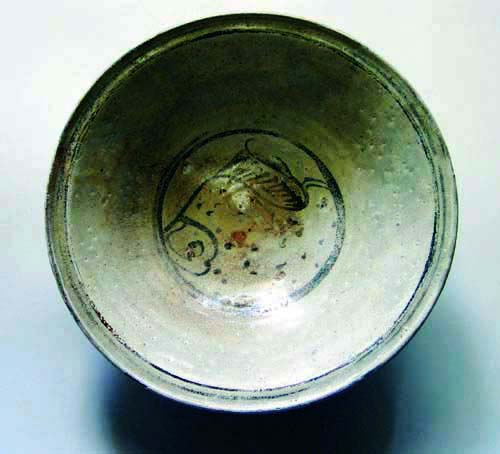 |
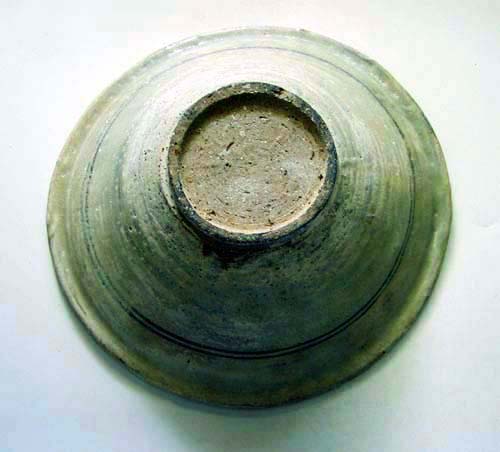 |
| Sukhothai iron black painted fish motif | |
The underglaze iron-painted Sukhothai wares come in limited vessel forms. The most common form is the big plate. Other form consisted of bowls, jarlets, vases and jars. The clay from Sukhothai is coarse as can be seen from the unglaze base. It has coarse grain and the finishing is relatively rough. A layer of white slip is applied, motif drawn and then a layer of transparent glaze applied before firing. The white slip is usually carelessly applied and visually appears to be of uneven thickness. Usually traces of the white slip not covered by the glaze could be seen near the lower part of the outer wall or even on the outer base. Some ceramics experts have suggested a Cizhou influence for these iron-painted wares. However, the Thai potters were most probably more directly influenced by the Vietnamese potters instead. Some examples of the Sukhothai iron painted floral bowls has a layer of brown coat over the outer base which is similar to that found on Vietnamese iron-painted wares. As in Vietnamese wares, spurred disc is used as separator for the stacking of bowls/plates in the kiln. On the interior, spur marks could be clearly seen.
|
|
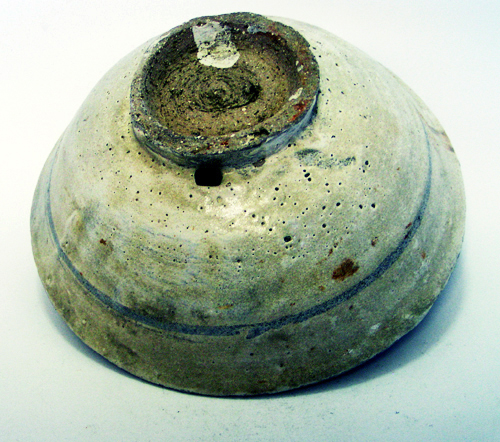 |
|
|
|
|
|
|
|
|
|
|
Some examples of Sukhothai iron painted wares |
|
|
|
|
So far, the earliest Sukhothai iron-painted wares were found in the Turiang shipwreck. Using the Longquan celadon in the wreck as a reference for dating, it is from the Early Ming period, most probably from around 1400 to 1420 A.D. Thai ceramics consisted about 35% of the cargo. There were also some Sawankhalok celadon jars and vases. Hence, it is not inconceivable that iron-painted wares were aready been produced by the late 14th century. The early Sukhothai iron painted wares are sparsely decorated with fish or floral motif. An elaborate version with floral scrolls on the inner wall was introduced later. The earliest examples were found the the Nanyang wreck which is dated to around the 1420s/30s. Bowls with only the fish decorated on the bottom continued to be part of the production.
|
|
|
|
Sukhothai plate with inner wall decorated with floral scrolls |
|
By this point of time, large celadon plates (or termed shallow bowls by some) from the Sawankhalok kilns were also produced. By 1450/60s, iron-painted Thai wares were scarcely found in the Southeast market and were so far not found in wrecks dated to Hongzhi period. They lost out in the competition to the Thai celadon and Vietnamese blue and white wares As a category with painted motif, they are less attractive as compared with the Vietnamese blue and white. By 1450, Vietnam was already producing high quality blue and white. The bulbous vase with peony and floral scrolls in the Topkapi Saray Museum shows the high artistic standard achieved by the Vietnamese potters. (For more on Vietnamese blue and white, please read this.). The decisive victory in 1471 A.D over Champa in Central Vietnam also ensured the Le Dynasty's control over the sea route along maritime sea route along Vietnam. The Hoi an shipwreck dated to about 1470s carried a cargo of more than 250,000 pieces of blue and white. It is the first convincing physical proof of their popularity.
Si Satchanalai (Sawankhalok) kilns also produced iron-painted wares at a slightly later date. The product range is even more limited and consisted of mainly plates and bowls. The earlier iron-painted Sawankhalok wares appeared very similar to those from Sukhothai. In the past, some have been wrongly identified as Sukhothai. In fact, Sawankhalok iron-painted motif appeears more constrained in its execution. The strokes are more controlled and less free. In comparison, the strokes seen in Sukhothai pieces appear to be more spontaneous. Even in the application of the white slip, those found in Sawankhalok pieces are more carefully applied and appear smooth and even. The clay is of better quality and the paste appears more fine grained. Usually, a circular scar mark of the disc support could be seen on the outer base. On a whole, Sawankhalok iron-painted wares constituted only a small number in the export market.
|
|
|
|
|
|
|
|
|
|
Sawankhalok Iron-black motif plate and bowl |
|
In the domestic market, underglaze iron black painted technique was also used for architectural ceramics for temples and the palace. Architectural ceramics includes sculptures, roof ornaments, decorative railings, tiles and etc.
|
|
|
|
15th Cent. Sawankhalok finial of mythical serpent (naga) |
|
Celadon Wares
Besides iron-painted wares, the Turiang shipwreck (1400/20 A.D) also carried some Thai Sawankhalok celadon small jars, both elongated and coconut shaped form with two lugs set on the shoulder and snuggling against the neck, and vases. The glaze shows more maturity as compared with the early Mon celadon plates. By the time of Nanyang shipwreck (1420/30s), finely potted big celadon plates with carved motif were produced. The glaze is relatively thick, smooth and even. In some examples, the glaze pooled to an attractive deep greenish or greenish blue tone on the inner bottom. Such big plates were very popular and continued to be produced to around the 1480s. The earlier plates were fired on spurred disc support and 3 spur marks could be seen on the interior bottom. Majority of those found in the Nanyang wreck has the spur marks. But this wreck also has some fired on tubular support which left a circular scar mark on the outer base. The use of spurred disc was replaced totally by tubular supports subsequently. Dr Brown also observed that circular scar mark of the earlier pieces tends to be bigger averaging around 8-9 cm in diameter. The later pieces has a smaller circular mark of about 5-7 cm. The external wall of the plate is either plain or decorated with carved vertical striations. The paste varies in quality, the good ones are more fine grained and show less black specks. The quality of the clay affects the glaze as the black specks will tarnish the appearance of the transparent glaze. There is still insufficient information available to build a chronology of the celadon plates base on decorative elements.
|
|
|
|
|
|
|
|
|
|
|
|
|
15th Sawankhalok plates and big bowls |
|
Besides plates, the more varied form of vessels were produced such as stem bowls, gourd shaped vases, Yuhuchun vases and ewers. The standard of the potting is good and the glaze thick and glossy.
|
|
|
|
|
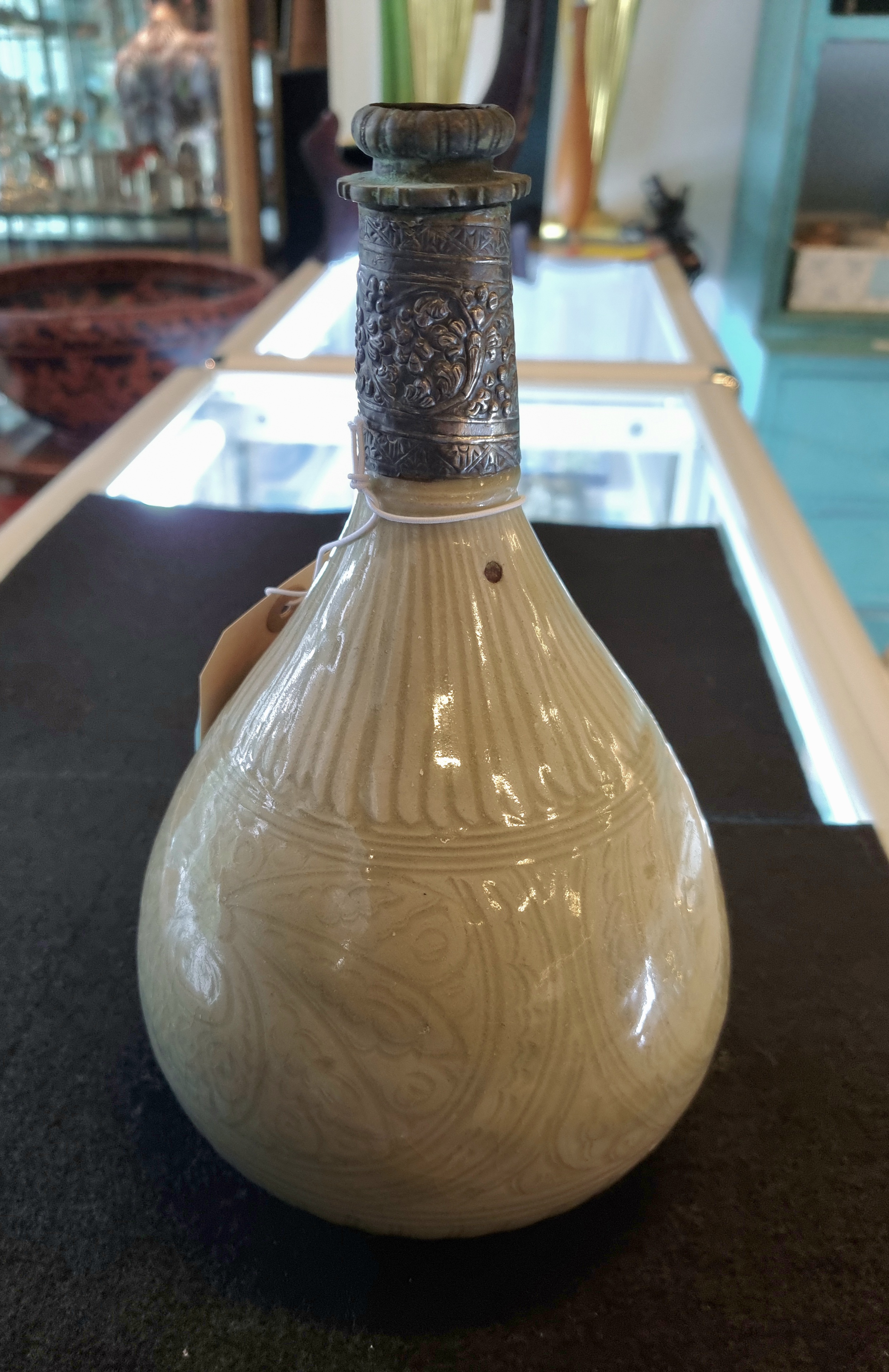 |
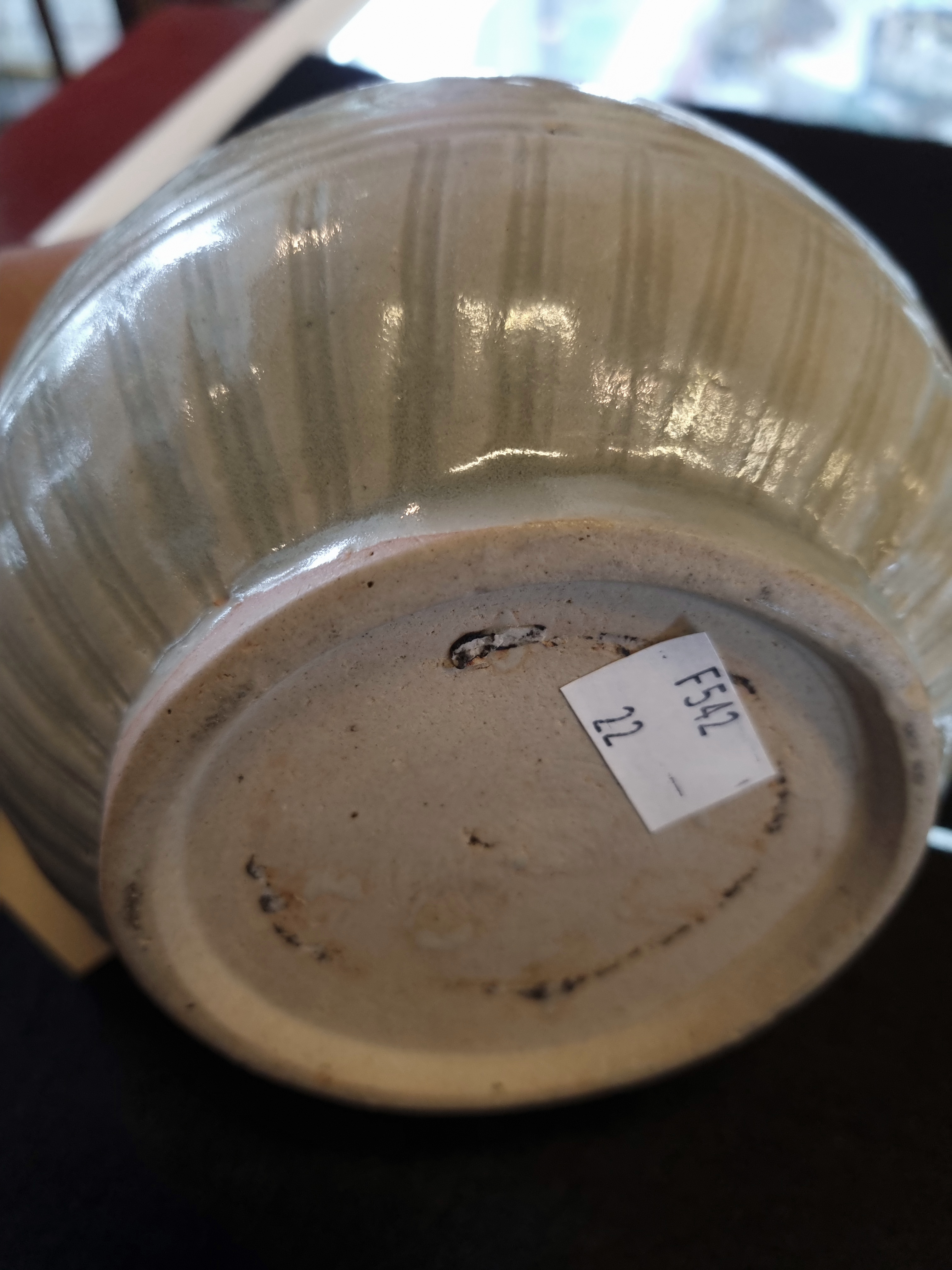 |
| 15th Cent. Yuhuchun vase with carved floral decoration |
For the domestic market, there is an interesting category of small figurines with majority showing a maternal figurine cuddling a baby. There are also other variations such as a male figurine carrying a cockerel or female carrying a lotus. Curiously, majority of the maternal figurines were deliberately broken at the neck. Some suggested that the figurines served a ritualistic purpose and were broken to protect pregnant women.
|
|
|
|
15th Sawankhalok celadon and brown glaze figurnes |
By the Ming Hongzhi period, production of big plates were phased out. Other smaller celadon vessels such as jars, vases and bowls continued to be exported in increasingly dwindling quantity till the mid 16th century. The quality of the pieces were poor as compared with the earlier pieces. The glaze appears thinner and runny in quality.
Brown Glaze Wares
Sawankhalok dark brown glaze vessels were part of the Thai Ceramics cargo for export market during the 15th and early 16th century period. Small jars (elongated and coconut shaped with two lugs) and vases were produced both in celadon and dark brown glaze.
|
|
|
|
Celadon and dark brown version of Coconut shape jar |
For the domestic markets, there are also impressive figurines and statues made in brown glaze.
|
|
|
|
15th Century Sawankhalok Brown glaze figurative examples |
|
Revival of underglaze iron black Wares
Before 1480s Ming blue and whites were only found in small quantity such as those in Royal Nanhai, Pandanan and Hoi an shipwreck. However, by 1500, (Ming Hongzhi period), Chinese blue and white wares emerged as the most highly demanded ceramics in Southeast Asia. Vietnamese blue and white and Thai celadon/brown wares lost consumer favour and the demand was low and the quality deteriorated drastically. In an attempt to revive interest in Thai ceramics, during the early 16th century (Zhengde period) the potters re-introduced decorations in underglaze iron-painted black. They were successful in identifying a niche in the cover boxes category. The potters adopted the Vietnamese jar/cover box partitioned composition but adapted the Chinese inspired floral scrolls for decoration. Besides cover boxes, there are also smaller number of other vessels such as vases, jars, kendi and bowls. Such iron black wares were recovered from the Espanola, Singtai and Xuande wreck which could be dated to the Zhengde period.
|
|
|
| Thai cover box and Vietnamese jar with decorations in vertically partitioned panels | |
|
|
Thai floral scrolls inspired by Chinese version (Hongzhi) on the right |
|
|
|
|
|
|
|
|
|
 |
|
 |
|
| Interesting jarlet in the form of a crab |
Interestingly, some Sukhothai bowls with iron-black painted the solar swirl (cakra) motif were also salvaged from the Xuande wreck. This is something new as Sukhothai kilns were thought to have ceased production by the 1460/80s.
 |
Brown/white and white wares of the 16th Century
During the early 16th century, the Thai potters also introduced wares with incised motif which is then glazed in opaque brown and white. This category is generally of high quality and the clay used is more fine grained less black specks. There are also some other interesting variations such as vessel left unglaze and decorated with brown spots. It was also during this period that opaque white glaze wares were introduced. The clay is generally of poor quality with black specks. It is covered with a layer of white slip and then glazed.
|
|
|
|
This figurine is partially covered with white glaze and other portion in unglaze state and decorated with brown spots. |
|
|
|
|
|
Jar with opaque white glaze. The paste is coarse showing much impurities. |
|
Kilns in Si Satchanalai and Sukhothai were destroyed during the Burmese invasion in the 1560s and production ceased and were not revived.
Table showing the key shipwrecks of 15th/16th century with Thai ceramics
The below table shows the main shipwrecks with Thai ceramics used by Dr. Brown in developing her chronology of Thai ceramics. The Chinese ceramics in the cargo mix are important in determining the dating of Thai ceramics.
| Period | Shipwreck | Type of ceramics | Additional information | ||
| Thai | Vietnamese | Chinese | |||
| Hongwu
- Xuande
(1368 - 1430 |
Rang
Kwien (Sank in Gulf of Thailand)
(ship of uncertain origin) |
Sawankhalok Mon type celadon plates, olive-brown glaze baluster jar, dark brown elongated jar with two ring handles on the shoulder, San Kampaeng plate, unidentified kiln pottery pots | Vietnamese iron-brown painted and underglaze blue bowls | Celadon jarlets with impressed motif and brown jars which most probably originated from Fujian kiln. Some celadon bowls and dish which could be from Longquan | Only 264 peices recovered. Too few to provide estimate of proportion and size of ceramic type in cargo. |
|
Song
Doc (Sank in South China Sea/Vietnam)
|
Sawankhalok Mon type celadon plates, San Kampaeng plate | Vietnamese iron-brown painted and underglaze blue bowls, plates and iron-painted and celadon jarlets | Longquan plates, brown jarlets most probably from Guangdong | There were quite substantial number of Vietnamese ceramics. | |
|
Turiang
(Sank in South China Sea/Malaysia)
(ship of Chinese origin) |
Sukhothai iron
painted black fish or /floral motif plates , jars and vases.
Sawankhalok iron painted plates with fish or floral motif. |
Iron painted floral motif bowl | Longquan celadon plates and jars, dark brown glaze jars, bowls and cover boxes | Wreck partially destroyed by trawling activities. About 1200 pieces recovered out of estimate of 8000, with 35% Thai, 57% Chinese and 8 % Vietnamese. | |
|
Ko
Si Chang II (Sank in Gulf of Thailand)
(ship of Chinese origin) |
Sawankhalok iron painted plates with fish or floral motif | Chinese celadon | Number of ceramics to few to estimate the proportion and size of each type in the cargo. | ||
|
Maranei
(Sank in Indonesian water)
(ship of Chinese origin) |
Sawankhalok iron painted floral motif plate, celadon and dark brown glaze jars. Sukhothai iron painted fish motif plates and vase, floral motif bowls and jars. Suphanburi and Singburi storage jars. | Iron-painted floral bowls, celadon jar and beaker | Chinese celadon and brown glaze wares | 1156 ceramics recovered. There were some 60 coins with latest from the Yongle period | |
| Xuande - Chenghua
1431 - 1488 |
Nanyang
(1424/50) (Sank in South China Sea near Malaysia)
(ship of Southeast Asian tradition)
|
Sawankhalok celadon, small number sukhothai iron painted plates | No Vietnamese wares | small number celadon and brown glaze wares | Estimated cargo of 10,000- 15,000 Sawankhalok celadon, a small number of sukhothai plates and chinese celadon and brown glaze wares. Earliest appearance of Sukhothai plates with fish encircled by floral scrolls on the inner wall. |
|
Longquan
(1424 /50)
(Sank in South China sea near Malaysia) (ship of Southeast Asian tradition) |
Sawankhalok celadon, sukhothai underglaze iron painted wares | No Vietnamese wares | Longquan celadon wares | Estimaed 100,000 pieces comprising about 40% longquan celadon, 20% Sukhothai underglaze and 20% Sawankhalok celadon | |
|
Kho
Kram (1450)
(sank in gulf of Thailand) (ship of South China Sea tradition) |
Sawankhalok celadon, small number Sukhothai underglaze iron black plates | Vietnamese blue and white, Champa green glaze | brown glaze jars | Estimated 5000 pieces comprising mainly Sawankhalok celadon, some Sukhothai underglaze black pates and small quantities Vietnamese blue and white, champa green glaze saucers and Chinese monochrome wares | |
|
Royal
Nanhai (1460)
(sank in South China sea near Malaysia) (ship of hybrid South China Sea tradition) |
Thai Sawankhalok celadon | 3 Vietnamese blue and white | Small number Chinese blue and white and brown glaze wares. ( In my opinion the blue and white could be dated to Zhengtong period about 1440 to 1450) | Estimated 20,000 mainly Thai Sawankhalok celadon | |
|
Pandanan
(1470)
(Sank near Palawan in Philippines)
|
Sukhothai and Sawakhalok ceramics | Champa ceramics, Vietnamese blue and white | Chinese blue and white. (In my opinion, they are dated to Jingtai to Tianshun ie 1450 to 1460) | 4722 pieces recovered consisting mainly of Champa ceramics and a dozen of Thai Sukhothai and Sawankhlaok dishes, 80 Vietnamese blue and white and some Chinese blue and white, celadon and brown glaze wares | |
|
Belankan
(1480 - 87)
(sank in Indonesia water)
|
Sawankhalok celadon plates | Vietnamese blue and white wares | Chinese blue and white. (In my opinion, they are dated to Tianshun to Chenghua ie 1460 to 1470) | Estimated 40,000 pieces comprising 80% Sawankhalok celadon, 18% Vietnamese blue and white and 2% Chinese blue and white | |
| Hongzhi -
Jiajing
1488 - 1567 |
Lena
cargo (1488 -1500) (Palawan Philipinnes)
|
small number of sawankhalok celadon jarlets, bowls and bottles | Some Vietnamese blue and white wares | Chinese blue and white. | Consisted of mainly Hongzhi blue and white wares. No sukhothai iron brown decorated wares or Sawankhalok big plates |
|
Ko
Samui (1500 - 1520)
|
Sawankhalok celadon and brown/opaque white glaze wares, white glaze and jarlet with brown spots. | First appearance of wares decorated with brown and opaque white glaze | |||
| Espanola | Sawankhalok iron painted cover boxes, Sawankhalok brown, white jars | First appearance of Sawankhalok iron painted cover boxes. | |||
| Singtai
(1520 - 1570) |
Sawankhalok iron painted cover boxes and bowls. Sawankhalok brown small jars. | ||||
| Xuande | Sawankhalok iron painted vases and cover boxes. Small number of Sukhothai iron painted bowls with the solar swirl (cakra) motif. | Chinese blue and white (In my opinion dated to Zhengde period ie around 1510-1520) | |||
Written by : NK Koh (16 Jul 2011)
References:
The Ming Gap and Shipwreck Ceramics in Southeast Asia - Roxanna Maude Brown